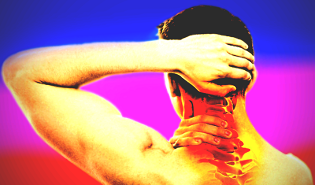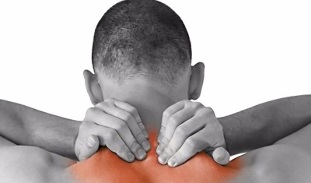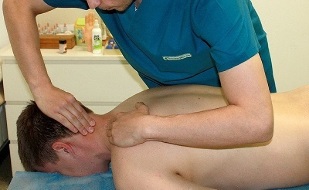Cervical osteochondrosis is a common disease accompanied by degenerative and dystrophic changes in the spine. The symptoms of the disease are the same in men and women. Treatment is prescribed by your doctor depending on the severity of the lesions and the patient's condition.
Symptoms of osteochondrosis in men
The main symptom of osteochondrosis of the neck is pain. There are several additional signs that help determine the presence of degenerative changes in the spine in the cervical spine.
Pain occurs in the background of disorders in the peripheral region, due to the detrimental effects of nerve roots and adhesions that connect tissues, plates, and muscles. In cervical osteochondrosis, men experience periodic or persistent pain. In the morning, the patient may feel dull pain deep in the neck.
Important!Feeling uncomfortable with turning your head, coughing, and sneezing.
Due to strong muscle tension, a person cannot breathe deeply. Pain can radiate to the occipital part of the head, indicating a change in the occipital nerve.

When you feel your upper cervical vertebrae, you may feel a painful lump. Compensating for nerve roots can radiate discomfort to the shoulders and arms.
Cervical osteochondrosis is characterized by degenerative processes in the intervertebral discs.
Deterioration of blood flow to nerve nodes leads to the following symptoms:
- burning pain in the back of the head;
- night numbness of the hands;
- swelling of the hands;
- irregular heartbeat;
- crackles and crackles when the head is rotated.
Vascular symptoms appear when the brainstem is affected. Cervical osteochondrosis disrupts the normal blood flow in the vertebral arteries. Underlying such pathological changes are neurotic failures:
- insomnia;
- unreasonable irritability;
- wobbly gait;
- dizziness;
- fast heart rate;
- excessive sweating;
- memory impairment.
In some cases, the performance of the visual device deteriorates. The risk of osteochondrosis is to provoke the development of the following syndromes:
- Narrowing. This is a narrowing of the spinal canal when the blood vessels in the brain are pinched by herniated intervertebral discs. The upper and lower limbs begin to numb.
- Reflex irritant. This syndrome is accompanied by burning pain in the back of the head.
- Root. With this pathology, the nerve roots are compressed by the intervertebral disc. The pains hurt, burn and throbb.
In most cases, the symptoms of osteochondrosis in men are almost the same as in women. When the first seizures of pain occur, the patient does not always suspect cervical osteochondrosis. Timely diagnosis helps to avoid complications.
Diagnosis of cervical osteochondrosis
X-rays are taken to diagnose the disease. It will help prevent spinal injuries. However, this research method does not provide an opportunity to view osteophytes. More modern diagnostic methods are used for this.

Assigned:
- computed tomography;
- magnetic tomography; Ultrasound examination of
- cervical vessels.
computed tomography (CT) is the creation of an X-ray sequence that shows the cervical vertebrae in volume. Such detailing makes it possible to assess the nature of nerve compression, the height of the discs, and the structure of osteophytes.
Magnetic resonance imaging is one of the most informative diagnostic methods. It allows you to assess the condition of bone structures. During the MRI, the doctor may detect the presence of a hernia.
Duplex vascular examination is used when a doctor suspects a bleeding disorder in the vertebral arteries.
Treatment of male osteochondrosis
The choice of treatment depends on the degree of damage and the general health of the man. In most cases, medication and physiotherapy are recommended.
HELP.Conservative therapy is intended to relieve pain and muscle cramps.
Physiotherapy activates the regenerative processes of cartilage tissue. Such procedures may be part of a comprehensive treatment or an independent method.
The following procedures are assigned:
- Electrotherapy.The affected areas of the spine are affected by electricity. This manipulation activates blood circulation. Contraindications include the presence of a pacemaker or metal parts in the patient's body.
- Magnetotherapy.This method is exposed to a permanent magnetic field. A procedure takes 20 minutes.
- Laser therapy.uses helium-neon lasers. They enhance bioelectrical processes in nervous system tissues. It has anti-inflammatory, analgesic and wound healing effects. The duration of exposure to one area does not exceed 2 minutes, the whole procedure takes about 14 minutes.
- Shockwave therapy.This type of exposure is rarely used as there is much debate about its effectiveness. The collision is given by acoustic waves. They help boost metabolism and activate blood microcirculation.
- Balneotherapy.The treatment is performed with mineral water and therapeutic mud. All beneficial substances penetrate the skin and act on receptors and nerve endings.
Gymnastic exercises should be performed to restore the mobility of the affected area. They help strengthen the muscle ligament and make the ligaments more flexible. The first workouts should be held under the supervision of a coach, as it is not the number of exercises performed that is important, but their technique.
Important!Surgery is indicated if medical treatment and physiotherapy have not produced the desired results.

This is called cervical discectomy. The doctor fixes the affected segment and removes the hernia that puts pressure on the spinal nerve. Over time, the vertebrae grow together. 3-5 days after surgery, the patient is cared for in an outpatient clinic.
The duration of the rehabilitation period is approximately 3 months. The exact time of rehabilitation depends on the implant and the professional activity of the operated patient.
In any case, it is advisable to start treatment of cervical osteochondrosis with a doctor. Self-medication can aggravate the course of the disease and lead to surgery.
Medicines for treatment
Medicines used to treat osteochondrosis should only be taken as directed by your doctor. It compiles the therapeutic regimen and selects the optimal dose.
The following groups of drugs are prescribed:
- analgesics;
- antispasmodics;
- anti-inflammatory drugs;
- vasodilators;
- chondroprotectors.
HELP.Active ingredients not only relieve cramps but also reduce the sensitivity of nerve endings.
Your doctor may prescribe non-steroidal anti-inflammatory drugs. These medications relieve pain and reduce inflammation.
It is recommended to use drugs as vasodilators to reduce blood viscosity. They improve blood microcirculation. Taking such medications promotes rapid recovery after treatment of cervical osteochondrosis.
The effect of chondroprotectors is to activate regeneration processes in damaged cartilage.

Improperly selected treatment can lead to the formation of a herniated disc. In cervical osteochondrosis, high blood pressure often occurs. If necessary, your doctor will prescribe medications to relieve the symptoms of this condition.
In order to make medication as effective as possible, it should be combined with therapeutic practices and physiotherapy procedures.
After chiropractic, try not to jerk your neck. The muscles relax to the maximum after the procedure and can reduce the positive effects of sitting.
Nutrition for osteochondrosis
In case of osteochondrosis, a person should pay special attention to his diet. It needs to be balanced as the body needs to get enough vitamins and nutrients.
The diet should include the following foods:
- vegetables and herbs;
- berries and fruits; dairy products and fermented dairy products;
- protein-rich foods;
- Foods containing gelatin and collagen.
Plant foods are high in vitamins and fiber. They have little energy value, which helps maintain a normal body weight. Parsley, cauliflower, beets and broccoli are particularly preferred.
The inclusion of sea buckthorn in the diet is recommended for patients with osteochondrosis. You can make a jelly based on fruits and berries. Fermented dairy products contain large amounts of calcium, vitamin D and phosphorus. These vitamins and nutrients strengthen bones and cartilage.
The following products should be present in the daily menu:
- fermented fried milk;
- cheese without preservatives;
- yogurt;
- cottage cheese.
It is important that dairy products and fermented dairy products are natural, free of colors and other harmful additives. Protein is essential for the formation of bone and cartilage tissue. Most are found in eggs, milk, whole grains and brewer's yeast.
Fish and seafood will be beneficial. They contain fatty and polyunsaturated acids that are needed for normal recovery of the body. Collagen is present in jelly, aspic fish and aspic. Promotes cartilage tissue synthesis.
HELP.Cold pressed olive oil is recommended instead of plain vegetable oil. It is important to maintain water balance.
Use only filtered or bottled water.
Most men seek medical attention when osteochondrosis is already at an advanced stage. Several symptoms indicate the development of a pathological condition. Timely diagnosis and treatment will help you avoid surgery and complications.



































